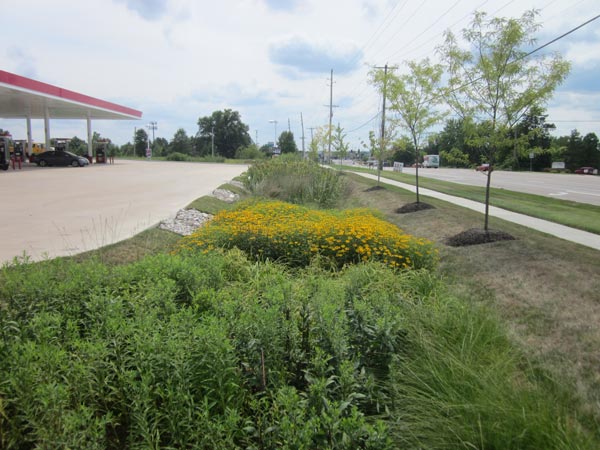
By Carol Davit, Executive Director
of Missouri Prairie Foundation
I recently scanned the pages of the business journal of a Missouri city. The renderings in an article about new construction projects illustrated sleek new buildings—some even touted as “sustainable”—yet in every drawing, the vegetation surrounding the buildings looked the same, like a stippled green afterthought.
Initiatives like LEED and other sustainable development rating systems have encouraged greater attention to the power of plants and effective landscape design to reduce the natural resource impact of buildings, and to improve human function in these places. The trend, however, is far from mainstream.
In 2007, the St. Louis Chapter of the American Society of Landscape Architects honored my organization, the Missouri Prairie Foundation, with its Civic Stewardship Award, for addressing “the most essential aspect of landscape architecture, the stewardship of native ecosystems.” I was pleased that ASLA recognized the critical importance of prairie—which once covered more than 15 million acres of Missouri, and occupied a 160-million-acre domain across North America—as foundational to designing outdoor spaces for people.
There simply is nothing else on earth that performs a multitude of functions that benefit people:
• With its complex and deep roots, prairie is like an incredible sponge that helps control flooding without expensive levees or other hardscape. In addition, the “water management” adaptations of prairie plants make them resilient in drought.
• An acre of intact prairie can absorb one ton of carbon in its roots and soil per year, helping to neutralize CO2 emissions.
• In Missouri, about 450 native bee, fly, butterfly and other insect pollinators occur on the totality of our remaining prairies. Because one-third of all our food crops are pollinated by insects, protecting native pollinator habitat is crucial to food security.
Just as we can’t recreate a tundra or a desert—we can’t “plant a prairie.” The original prairie ecosystem is too complex for human duplication. It is feasible, however, to design, install, and maintain plantings featuring prairie plants to harness the power of prairie for human benefit.
Numerous successful prairie plantings in the St. Louis area provide examples for others to follow: at Shaw Nature Reserve, Alberici Construction headquarters, and a seven-acre residence in West County that St. Louis Homes and Lifestyles recently named its 2016 Garden of the Year, to name but a few.
From established prairie plantings, these landowners gain beauty, increased ecological interactions, water management efficiency, and cost savings. Hard numbers on the benefits of similar plantings have been captured, as well, and are documented at landscapeperformance series.org.
Instead of mere “green stippling” on a plan, Midwestern landscaping can include native prairie plants—each with a name and a place on this earth. Each plant can work to our benefit, simply by being chosen to grow.
Carol Davit is the executive director of the 50-year-old Missouri Prairie Foundation, the mission of which is to protect and restore prairie and other native grasslands through land acquisition, management, education and research. MPF also runs the Grow Native! program. For resources on landscaping with prairie plants and other natives, visit www.moprairie.org and www.grownative.org.
To hear more about this topic as well as efforts being done to perennialize edible crops for production-scale agriculture in prairie polycultures, join the USGBC-Missouri Gateway Chapter, the Missouri Botanical Garden, BiodiverseCity St. Louis, and the Academy of Science St. Louis for Prairie Polycultures: Sustainable, Edible Landscapes on October 18th from 5:30 – 7:30 pm at Alberici, 8800 Page (63114). Learn more and register at www.usgbc-mogateway.org.


